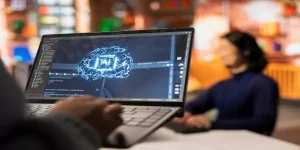The Future of Web Design: Integrating AI Driven Tools into UX/UI Workflow

The digital landscape is changing at an extraordinary pace, and web design sits at the forefront of this transformation. User expectations are shifting quite rapidly and the demand for seamless experiences, personalised content and visually captivating interfaces growing stronger by the day. As a result, designers are increasingly turning to the new emerging technologies to keep up with these expectations.
Among the most influential of these technologies is Artificial Intelligence (AI) which is reshaping the very foundations of how websites are created, designed and optimised. This article looks at how AI tools are becoming a big part of UX/UI workflows. They enable designers to work faster, come up with fresh ideas and make designs more user friendly.
AI can do things like speed up tedious chores and provide useful feedback, while you work. It’s more than simply a useful tool; it’s becoming a creative collaborator. Finally, incorporating AI into design, opens up a new chapter in which human creativity and smart technology, collaborate to create superior digital experiences.
1. Automating Repetitive Design Tasks
Traditionally, web designers spent a substantial amount of time managing repetitive processes, like resizing images, creating layout grids and assuring cross device compatibility. AI tools are now automating these tasks, freeing designers to concentrate on creativity and strategy. For example, AI powered platforms can instantly generate responsive designs, test colour contrasts for accessibility or even suggest optimal typography pairings.
This trend is especially significant in web designing in Gold Coast where firms compete to stand out in increasingly saturated digital markets. By reducing repetitious tasks, AI tools enable designers to provide outputs more quickly while maintaining high quality.

2. Enhancing Personalisation Through Data Driven Insights
One of the most significant contributions AI makes to UX/UI design is customisation. By studying user behaviour data AI can assist designers in creating experiences that feel personalised to individuals. For example, AI may assess surfing habits, predict user needs and recommend design features that appeal to specific audiences.
For businesses, this implies increased engagement, greater customer loyalty, and more effective digital marketing strategies. In reality, a website’s layout or content may alter in real time based on user interactions, ensuring that each visitor receives a unique and relevant experience.
3. Intelligent Prototyping and Wire Framing
Prototyping and wire framing are critical stages in any web design project, but they may be time consuming. AI tools are easing these procedures, by producing rapid, functioning prototypes with minimum input. Designers can enter basic designs or project criteria and AI powered platforms will generate draft wireframes that can be improved.
This not only shortens project timelines, but also gives greater flexibility for experimentation. Designers can iterate, several ideas in less time allowing for a more thorough examination of creative alternatives, before settling on a final design.
4. Improving Accessibility with AI
Web accessibility is no longer a secondary concern; it is an essential component of current web design. AI is playing an important role in making websites inclusive, and usable for everyone. From automatically producing alt text for photos, to flagging possible accessibility concerns in layouts, AI powered technologies are making compliance simpler.
For example, some platforms may mimic how people with colour blindness or visual impairments will interpret a website, allowing designers to make proactive changes. Integrating such features, guarantees that site design not only adheres to legal norms, but also promotes inclusivity, and equity in digital places.

5. AI in Visual and Content Creation
AI’s effect extends beyond structure to the aesthetics of design. With tools capable of producing high quality images, icons and even written material designers are discovering new ways to strike a balance between efficiency and creativity. While AI may generate design elements at scale, human designers retain creative control, to guarantee that the end product is consistent with brand identity.
For instance, AI can propose multiple layout variations or colour schemes, from which designers choose and refine the most suitable option. This partnership, between human intuition and machine accuracy produces speedier and more innovative results. Businesses that provide web designing in the Gold Coast are already using these technologies to generate competitive, on brand designs without exceeding budget.
6. Ethical Considerations and the Human Touch
As AI gets more integrated into design processes ethical concerns arise. Issues such as over reliance on automation, employment displacement, and the risk of homogenised designs must be addressed. While AI clearly excels at precision and data driven knowledge, it cannot replace the empathy, creativity and cultural sensitivity that human designers have.
As a result, the future of UX/UI design lies in establishing a balance between AI as a facilitator of better workflows and people as visionaries who ensure designs are authentic, engaging, and ethically sound. After all the most effective web experiences combine technical excellence with human narrative.
7. The Road Ahead: AI as a Design Partner
AI is playing an increasingly important role, in site design. It will soon be able to recommend design ideas, assess how consumers interact with websites and better integrate with marketing tools. Businesses and organisations, who adopt these technologies early will have an advantage, resulting in faster and better design results.
Artificial intelligence will not replace designers; rather, it will improve their job. Regardless of whether, it’s a small business looking for an affordable services for web designing in Gold Coast, incorporating AI into design marks the beginning of an exciting new era.

Wrapping Up
AI is changing web design by automating tasks, improving accessibility, and making websites more personalised. But great design still needs human creativity, empathy, and understanding. The future lies in combining both; AI doing the hard work while designers focus on creating experiences that truly connect with people.